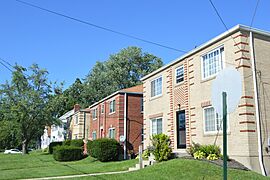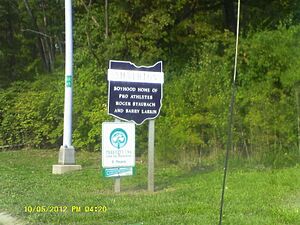Silverton, Ohio facts for kids
Quick facts for kids
Silverton, Ohio
|
|
|---|---|

Post-World War II housing on Silverton Avenue
|
|
| Motto(s):
"A Front Porch Community"
|
|

Location in Hamilton County and the state of Ohio
|
|
| Country | United States |
| State | Ohio |
| County | Hamilton |
| Government | |
| • Type | Council-Manager |
| Area | |
| • Total | 1.11 sq mi (2.88 km2) |
| • Land | 1.11 sq mi (2.88 km2) |
| • Water | 0.00 sq mi (0.00 km2) |
| Elevation | 820 ft (250 m) |
| Population
(2020)
|
|
| • Total | 4,908 |
| • Density | 4,409.70/sq mi (1,702.41/km2) |
| Time zone | UTC-5 (Eastern (EST)) |
| • Summer (DST) | UTC-4 (EDT) |
| ZIP code |
45236
|
| Area code(s) | 513 |
| FIPS code | 39-72522 |
| GNIS feature ID | 1086228 |
Silverton is a village located in Hamilton County, Ohio, in the United States. It was created from parts of two other townships. In 2020, the population of Silverton was 4,908 people.
Contents
History of Silverton
Silverton started after the Revolutionary War. In 1809, David Mosner opened a general store where two roads met. For many years, the area was called "Mosner" or "Enterprise." In 1861, a post office opened, making the name "Mosner" official.
Growth and New Name
In 1883, a railway line opened, connecting the area to Cincinnati. Soon after, Seth Haines and Robert Cresap planned the first neighborhoods in Silverton. Many believe the town was renamed Silverton to honor Seth Haines' wife, Elizabeth Silver Haines.
In 1884, the community officially became the Hamlet of Silverton. A hamlet is a very small settlement. The first neighborhoods had large lots, but the houses themselves had narrow fronts.
Over the next 20 years, Silverton grew into a suburb. In 1904, it became a village after a public vote. People could easily travel to jobs in Cincinnati using the railway.
By 1910, Silverton had 459 residents. It continued to grow, and by 1961, its population was over 5,500, making it a city for a while.
Local Business and Community Changes
Around the early 1900s, the John C. Meier Grape Juice Company bought land near the railroad. They started making grape juice and wine. Today, this company is known as Meier's Wine Cellars. It is the oldest and largest winery in Ohio.
In the 1960s, more African-American families moved to Silverton. Unlike some other places, Silverton did not experience "white flight" (when many white residents move away). Groups like the Silverton Neighborhood Association helped people from different backgrounds connect. Because of this, Silverton became a community where people of all races lived together peacefully.
In 1974, Richard F. Hunter, Sr. became Silverton's first African American Mayor. He had served on the village council before. Mayor Hunter was mayor for over 20 years, longer than anyone else in Silverton's history.
In 2008, Silverton was recognized as a Tree City USA community. This means they care about their trees and green spaces.
Geography
Silverton covers a total area of about 1.11 square miles (2.88 square kilometers). All of this area is land.
Population Information
| Historical population | |||
|---|---|---|---|
| Census | Pop. | %± | |
| 1910 | 459 | — | |
| 1920 | 795 | 73.2% | |
| 1930 | 1,843 | 131.8% | |
| 1940 | 2,907 | 57.7% | |
| 1950 | 4,827 | 66.0% | |
| 1960 | 6,682 | 38.4% | |
| 1970 | 6,588 | −1.4% | |
| 1980 | 6,172 | −6.3% | |
| 1990 | 5,859 | −5.1% | |
| 2000 | 5,178 | −11.6% | |
| 2010 | 4,788 | −7.5% | |
| 2020 | 4,908 | 2.5% | |
| U.S. Decennial Census | |||
2020 Population Details
In 2020, Silverton had 4,908 people. The population density was about 4,409 people per square mile.
- About 47.5% of the people were White.
- About 41.7% were Black or African American.
- About 1.3% were Asian.
- About 6.4% were from two or more races.
- About 4.5% of the population identified as Hispanic or Latino.
There were 2,499 households. A household is a group of people living together.
- About 18.6% of households had children under 18.
- The average household had 1.91 people.
The average age of people in Silverton was 44.1 years old.
- About 17.6% of the population was under 18.
- About 22.5% was 65 or older.
The average yearly income for a household was about $46,029. About 18.9% of the population lived below the poverty line.
2010 Population Details
In 2010, there were 4,788 people living in Silverton. Because the population dropped below 5,000, Silverton officially became a village again instead of a city.
- About 44.0% of residents were White.
- About 51.4% were African American.
- About 2.5% were Hispanic or Latino.
The average age in Silverton was 43.3 years.
- About 15.9% of residents were under 18.
- About 16.8% were 65 or older.
Community Services and Parks
Silverton provides many services for its residents. The Hamilton County Sheriff's Office helps keep the village safe. Silverton also shares a fire department with nearby Deer Park. This department provides fire protection and emergency medical services (EMS).
Silverton has two parks for everyone to enjoy: Ralph Ficke Memorial Park and Silverton Park.
Ralph Ficke Memorial Park
Ficke Park used to be a large park with a playground, baseball fields, a soccer field, basketball courts, tennis courts, and a batting cage. It also had shelters for events. The park hosted fun events like an annual Easter egg hunt and summer concerts.
Later, the village council decided to share half of Ficke Park with Cincinnati Public Schools. This allowed a new school to be built there. Some of the park's facilities, like the shelters and tennis courts, were removed for the school construction. Some of these facilities are planned to be rebuilt in the remaining part of the park.
Silverton Park
Silverton Park is located in the center of town. It has a "village green" feel, like a town square.
Inside Silverton Park, you'll find the Kuhnell Museum. This museum is a copy of the village's original train station. It's a special place for Silverton residents. Johnny Kuhnell, who was the village's Chief of Police for many years, wanted to rebuild the station as a community landmark. His dream came true in 1974 when the replica was finished. The museum was later named in his honor.
The Kuhnell Museum helps preserve Silverton's history. It has old photographs, articles, and items from the 1800s to today. Visitors can learn about the village's past. The museum is open to the public on the second and fourth Sunday of each month, from 2:00 p.m. to 5:00 p.m., between April and September.
Famous People from Silverton
- Barry Larkin: A famous baseball player and member of the MLB Hall of Fame.
- Carl Lindner: A successful business leader and CEO of a Fortune 500 company.
- Roger Staubach: A Heisman Trophy winner and NFL Hall of Fame quarterback.
See also
 In Spanish: Silverton (Ohio) para niños
In Spanish: Silverton (Ohio) para niños


